Table of Contents
I’ve used several different tools over the years, ranging from all-in-one CRM platforms to a simple project management system that I’ve automated to fit my needs. Ultimately, the best CRMs support sales activities, customer service, and customer retention.
In a perfect world, CRMs should also integrate with any marketing software to make for a smooth transfer of data. However, that’s not always the case — and that’s okay too. In my experience, starting somewhere and working to integrate is more effective than waffling on a decision, waiting for the perfect solution, and not ending up with any systems or processes for tracking customer data.
What’s more, with nearly every tool on the market bringing AI into the mix — the insights and integrations will only get better.
Whether you’re just starting out or are looking for a CRM that meets your needs better than the current solution, I’ve evaluated the following list.
Here are 12 CRMs available today and examples of how you might use them.
1. HubSpot
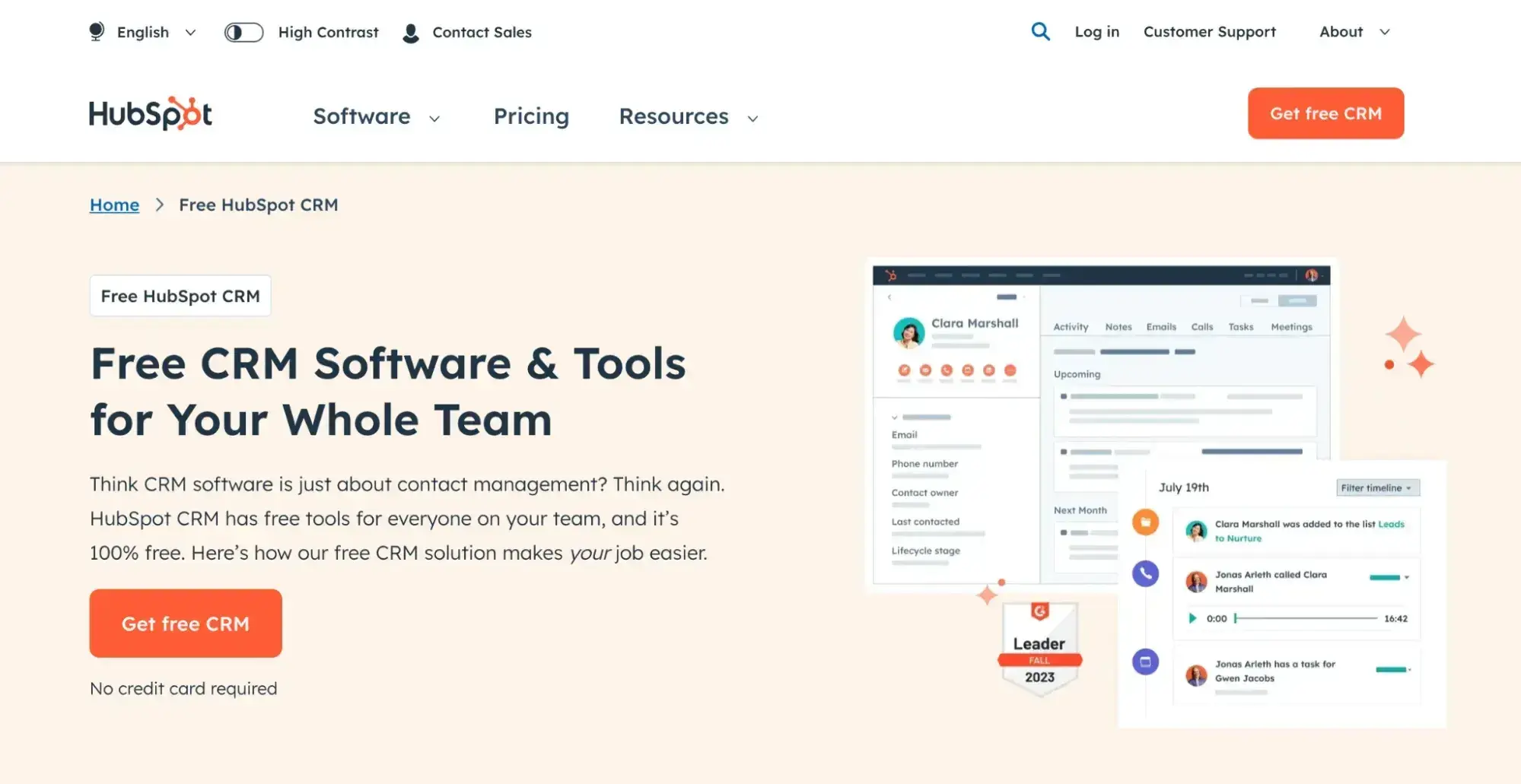
HubSpot is a CRM platform — meaning, it tracks customer relationships, as well as facilitates marketing, sales, and service processes. HubSpot is ideal for any scaling business (whether you’re small, mid-sized, or enterprise) and any team (such as marketing, sales, customer service, operations, or C-suite).
The platform combines Marketing Hub, Sales Hub, Service Hub, and Content Hub — along with hundreds of available integrations — to help you align all internal teams, gather meaningful insights, report on (and share) success and growth opportunities, create remarkable customer experiences, increase adoption, and delight your target audience throughout every moment of the buyer’s journey.
HubSpot serves as a single source of truth when it comes to managing your customer relationships — and with an exceptionally easy user experience (UX), you can spend more time on your customers and less time on software management and manual activities.
And speaking of your customers, they are a major part of what differentiates HubSpot from other CRMs on the market — HubSpot centers everything you do around your customers and the customer experience. As a result, you’re able to grow better and help your customers grow better, too.
Example of HubSpot in Use: Align Your Data
HubSpot syncs every interaction that happens between you and a contact to that contact’s timeline. This creates a single source of truth for every member of your team, from sales to marketing to service to ops.
This also makes it easy for your team to refer to and apply that contact data as needed. As a result, you’ll have the data alignment that’s necessary to effectively increase customer loyalty and delight.
Not to mention, you’ll be saving time in the process since HubSpot will enter, sync, and update your contact data for you — no more manual entry.
For some teams, that synced data isn’t just used behind the scenes - it’s surfaced more visibly to keep everyone aligned. Thanks to HubSpot’s customizable dashboards and clean UX, it’s easy to adapt them for high-visibility moments: pinning to Slack channels, reviewing in daily standups, or displaying on digital signage in communal spaces. These touchpoints help reinforce priorities, celebrate wins, and spotlight pipeline activity without asking people to dig through tabs or reports.
Did You Know? HubSpot Marketing Hub customers saw a 505% return on investment over three years. Check out our whitepaper for more insights into the business value of Marketing Hub (just like this one).
Testing It Out
A core part of HubSpot’s CRM is its predictive lead-scoring software, which uses machine learning to parse through thousands of data points to score leads. I found the setup process straightforward, and within minutes, the system started analyzing existing leads and assigning them scores based on their likelihood to convert.
By leveraging historical data and analyzing patterns in lead behavior, the software was able to prioritize leads who were genuinely interested in our offerings. Not only could the tool identify high-potential leads on its own, but it also allows me to create up to 25 different scoring systems to ensure that each lead is qualified adequately.
Overall, my experience with HubSpot’s predictive lead-scoring software was positive. Not only did it save me time, but it also improved the accuracy of my lead prioritization process.
Pricing
HubSpot CRM itself is a free tool, but the Hubs — including the Marketing, Sales, Service, Content, and Operations Hubs — are paid products.
- Marketing Hub. Starts at $15/month/seat (Starter), $800/month (Professional,) and $3,600/month (Enterprise)
- Sales Hub. Starts at $15/month/seat (Starter), $90/month/seat (Professional), and $150/month/seat (Enterprise).
- Service Hub. Starts at $15/month/seat (Starter), $90/month/seat (Professional), and $150/month/seat (Enterprise).
- Content Hub. Starts at $15/month/seat (Starter), $450/month (Professional), and $1,500/month (Enterprise).
- Operations Hub. Starts at$15/month/seat (Starter), $720/month (Professional), and $2,000/month (Enterprise).
These prices are billed annually.
2. Salesflare

Salesflare is a B2B sales CRM platform, as it's specifically built to track and organize your B2B operations. Their CRM automatically creates contacts and enriches them with additional details, including email signatures and complete customer timelines. The CRM then nudges you to follow up.
The Salesflare CRM has a built-in email sequence tool that allows you to send personal emails at scale, which can make your outreach way more efficient. And if you‘re a heavy LinkedIn user, you’ll appreciate their LinkedIn sidebar too, which allows you to create contacts from LinkedIn and find their email, all in a few clicks.
Example of Salesflare in Use: Track Your Sales
If you're in B2B sales, it can be hard to keep track of every lead in your pipeline in an organized way. Sometimes, leads slip through the cracks, you can forget details, or you can follow up a little too late and lose the momentum.
That's exactly what a B2B sales CRM platform like Salesflare is built for. It makes it very easy to keep track of your leads, so you don't have to miss any details or lose out on revenue. Salesflare is also a great tool for sales managers who want to keep an eye on what their team is doing and coach them accordingly.
Testing It Out
When I tested Salesflare, two features stood out to me: the automated data entry and email & meeting integration features.
The automated data entry was seamless; as soon as I connected my email and social accounts, Salesflare began pulling in information and populating customer profiles without any manual input from me. I found that the CRM automatically gathered details like contact information, company data, and even social media profiles to create comprehensive records for each lead and customer.
The email and meeting tracking feature was equally impressive. Every email I sent and received was automatically logged into the CRM, along with details about when it was opened and links the recipients clicked. This gave me a clear view of how engaged my leads were and helped me prioritize follow-ups.
The platform also tracked every meeting I scheduled and added it to the timeline, complete with notes and action items, which ensured I never missed a meeting and had all the context I needed for each interaction.
Pricing
30-day free trial available. The paid plans include:
- Growth. $29/user/month.
- Pro. $49/user/month.
- Enterprise. $99/user/month.
These plans are billed annually. If you want to register more than five users for the Enterprise plan, you’ll need to contact Salesflare’s team.
3. EngageBay
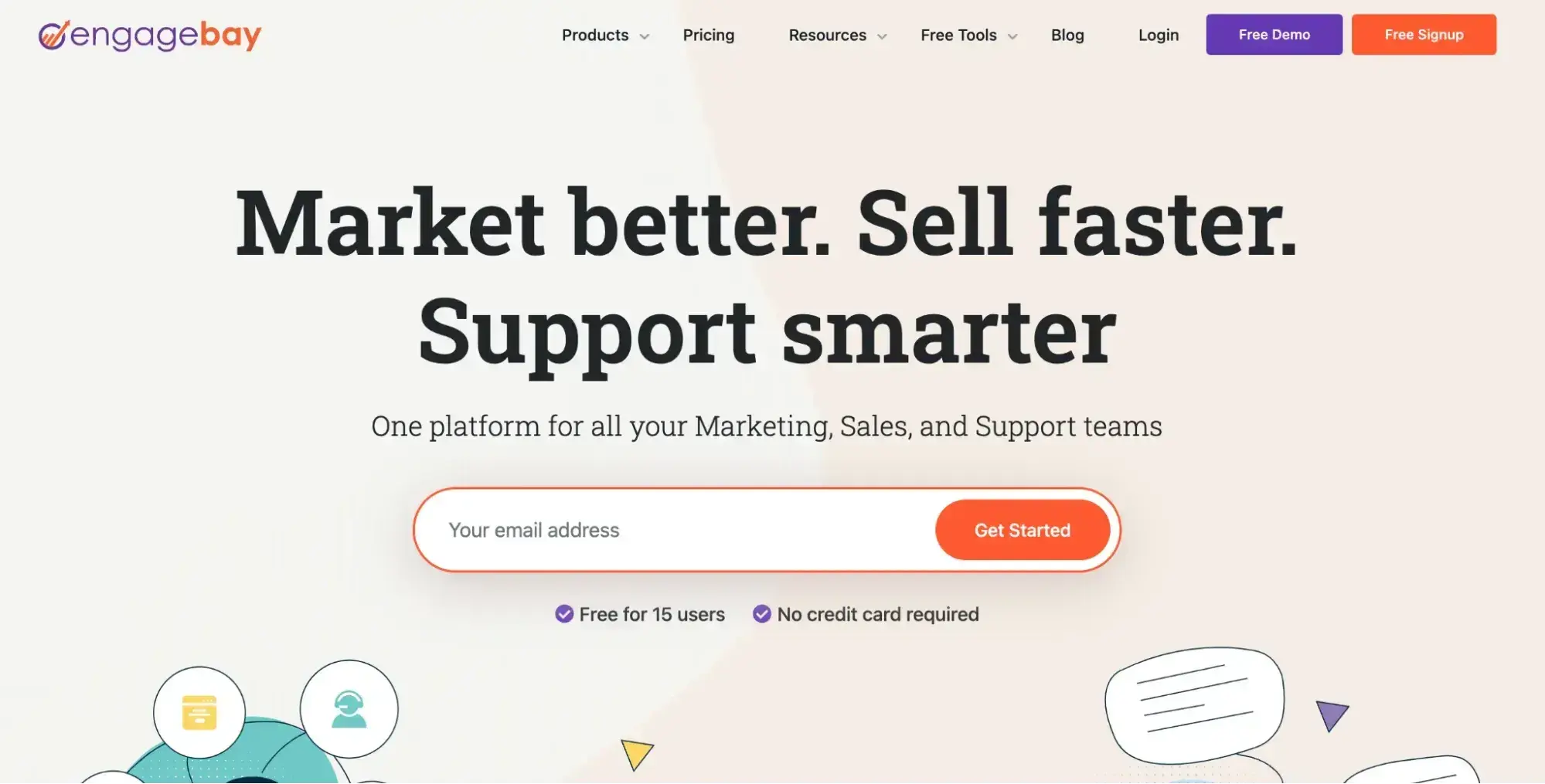
EngageBay helps small businesses manage customer relationships and sales processes effectively. It provides a wide range of features such as contact management, sales automation, lead capture, and marketing automation.
EngageBay is also used by companies to manage their sales and marketing efforts. The software provides users with tools to create and track leads, as well as follow up on sales opportunities.
EngageBay also helps companies measure their marketing campaigns to see what’s working and what isn’t so they can adjust their strategies accordingly.
Overall, EngageBay is an excellent CRM for businesses of all sizes. It is easy to use and comes at quite an affordable price too.
Examples of EngageBay in Use: 360-Degree Customer View
In today’s world, having a complete view of your customer’s journey is paramount. By leveraging data from various channels, companies can begin to understand their customers on a deeper level. That’s what EngageBay’s unified CRM does.
The all-in-one platform connects all the tools and sources its data from the CRM, allowing teams to work in tandem with real-time information.
The 360-degree view draws on each customer’s source, scores, and calls, and offers a complete picture to the business owner or sales manager. This helps sales teams discover new opportunities, close deals, and predict what the customer preferences could be.
Testing It Out
EngageBay’s AI-powered deal management software is incredibly efficient and user-friendly. The automated deal tracking provided real-time updates and prioritized deals based on predefined conditions. This meant that I could focus on high-priority deals without getting bogged down with manual tracking.
The AI-driven predictive analysis was particularly impressive, too. It gave insights into which deals were likely to close and which I needed to pay more attention to. This allowed me to allocate my time and resources more effectively, ensuring no deal was neglected.
The visual sales pipeline was another highlight; the drag-and-drop interface made it easy to manage deals. I could easily move deals through different stages and get a clear overview of their progress.
This visual approach — coupled with the AI and automation features — significantly streamlined my deal management process and increased my overall productivity.
Pricing
There’s a free forever plan available. The all-in-one paid plans include:
- Basic: $13.79/user/month
- Growth: $59.79/user/month
- Pro: $110/39/user/month
These plans are billed annually. They also offer standalone solutions for Marketing and CRM & Sales Bay depending on your needs.
4. Microsoft Dynamics
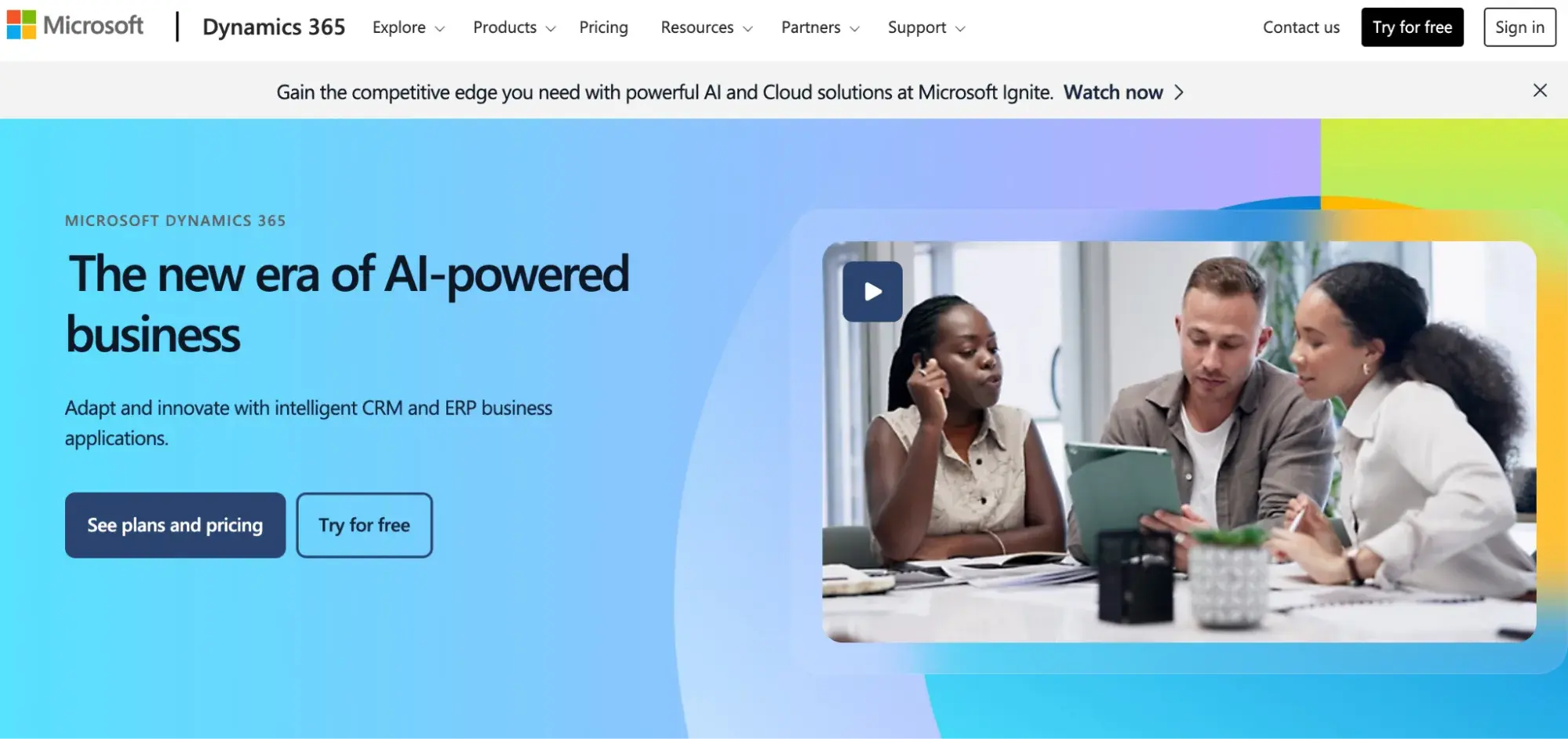
Microsoft Dynamics is a CRM and enterprise resource planning (ERP) software meant to improve sales and marketing productivity. The CRM gathers social insights, provides cloud-based campaign management, and offers business intelligence.
Choose to have your CRM delivered by cloud, hosted, or on-premises. Microsoft Dynamics offers apps so you can manage your relationships with customers on mobile as well as integrate and sync data from social media with your CRM.
Example of Dynamics in Use: Get In-Depth Customer Insights
A CRM has the power to provide a 360-degree view of your customers, and Microsoft Dynamics is no exception. The CRM’s real-time customer data platform provides AI-powered insights that tell you how to acquire valuable leads and customers, who your audience members are, what they need, how you can delight them, and more.
There are also real-time insights about your customers based on behavioral, demographic, and transactional data as well as engagement and customer feedback (e.g., survey data). This allows your team to apply these insights for targeted and personalized sales, marketing campaigns, support, and more.
Testing It Out
Microsoft Dynamics has a dedicated AI tool that aims to transform the workflow and customer management processes. When I tested it, the automation features stood out to me; the AI-assisted email drafting and meeting summaries saved a considerable amount of time, and the automated data entry (and intelligent reminders) ensured that I never missed important follow-ups.
Customer insights were another great feature. Dynamics 365 AI aggregated data from various touchpoints, providing a comprehensive view of customer behavior and preferences. This allowed me to tailor my interactions and campaigns more effectively. The AI-driven segmentation also allowed me to identify high-value customers and target them with personalized offers, which can boost conversion rates.
Dynamics 365 AI also lends itself to customer service in that AI-powered virtual agents can handle routine inquiries efficiently, freeing up human agents to focus on more complex issues.
The system’s ability to analyze customer interactions and provide real-time suggestions helps improve the quality and speed of responses.
Pricing
30-day free trial available. The paid plans range from $65/user/month to $1,000/tenant/month, depending on the use case you choose.
5. Salesforce
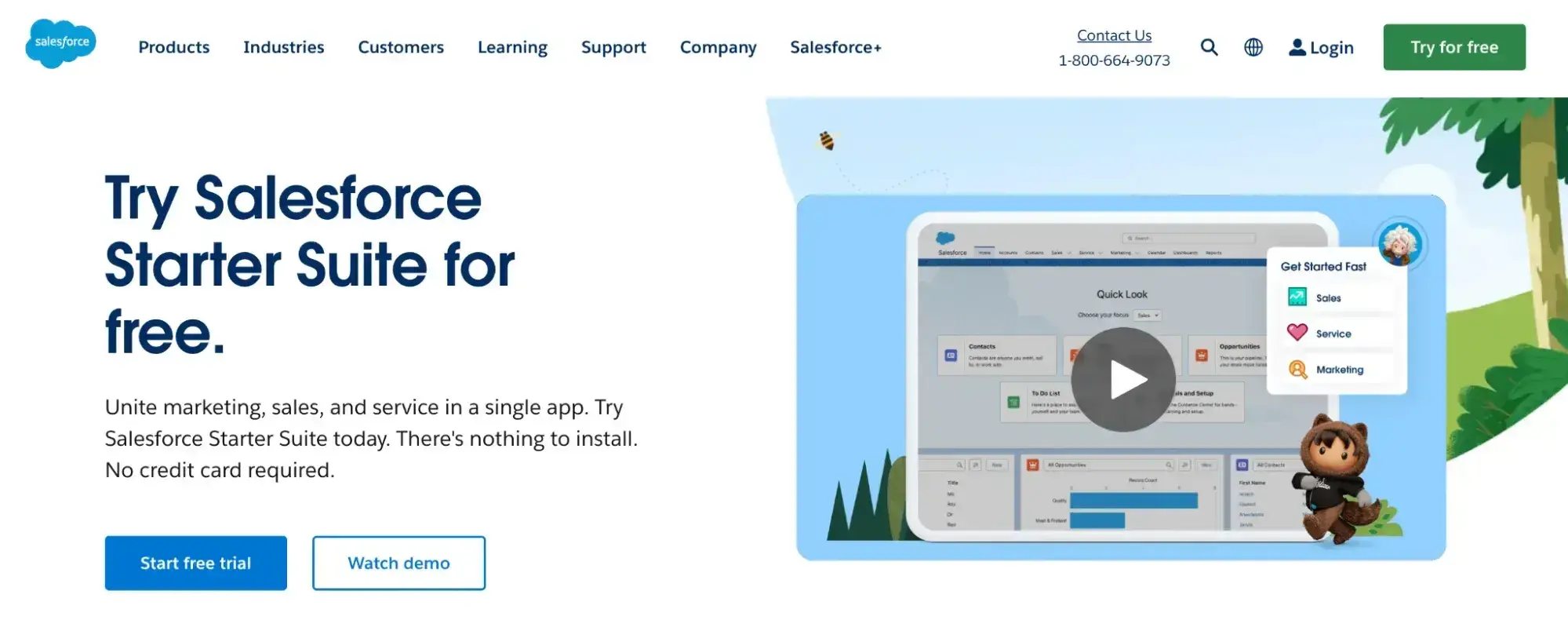
Salesforce’s CRM, Customer360, brings customer data plus sales, service, marketing, commerce, IT, and analytics together in a single location for quick access, shareable insights, and easy collaboration. The CRM is capable of lead and contact management, sales opportunity management, workflow rules, automation, and customizable reports and dashboards. It’s also accessible via a mobile app.
Salesforce offers a number of apps — such as Einstein AI — that make it easier to achieve your unique goals. There are also Employee Experience features within the tool to simplify work collaboration and increase motivation.
Example of Salesforce in Use: Automate Repetitive Tasks
Like many CRM options, Salesforce automates repetitive and time-consuming tasks.
The Einstein AI feature uses AI to provide your team with data about all past interactions with customers. This allows you to engage more thoughtfully and improve business communications and relationships. It also increases productivity by providing your team with the information they need, such as intelligent case classification and next actions.
Einstein AI also makes the process of providing remarkable customer service and support easier by recommending certain actions to reps, personalizing support for customers, and automating support when possible with bots to save reps time.
Testing It Out
Salesforce created a dedicated AI-powered tool to support its CRM, and when I tested it, I found its features to be very effective at providing actionable insights and increasing productivity.
With AI-powered predictive analysis, I could easily get forecasts on sales trends, which can help me make more informed decisions and focus on high-potential leads. Einstein also suggested personalized email content based on customer data, which significantly improved my outreach efficiency.
The conversational AI capabilities also stood out to me. I can use Einstein to generate summaries of sales calls and customer interactions, which saved me a ton of time on manual note-taking. The ability to automate routine tasks and receive real-time predictions on deal closures helped streamline my workflow, allowing me to concentrate more on strategic activities.
Pricing
30-day free trial available. The paid plans range from $25/user/month to $1,500/seat/month, depending on the use case you choose. You might need to call Salesforce’s team for custom pricing.
6. Zoho
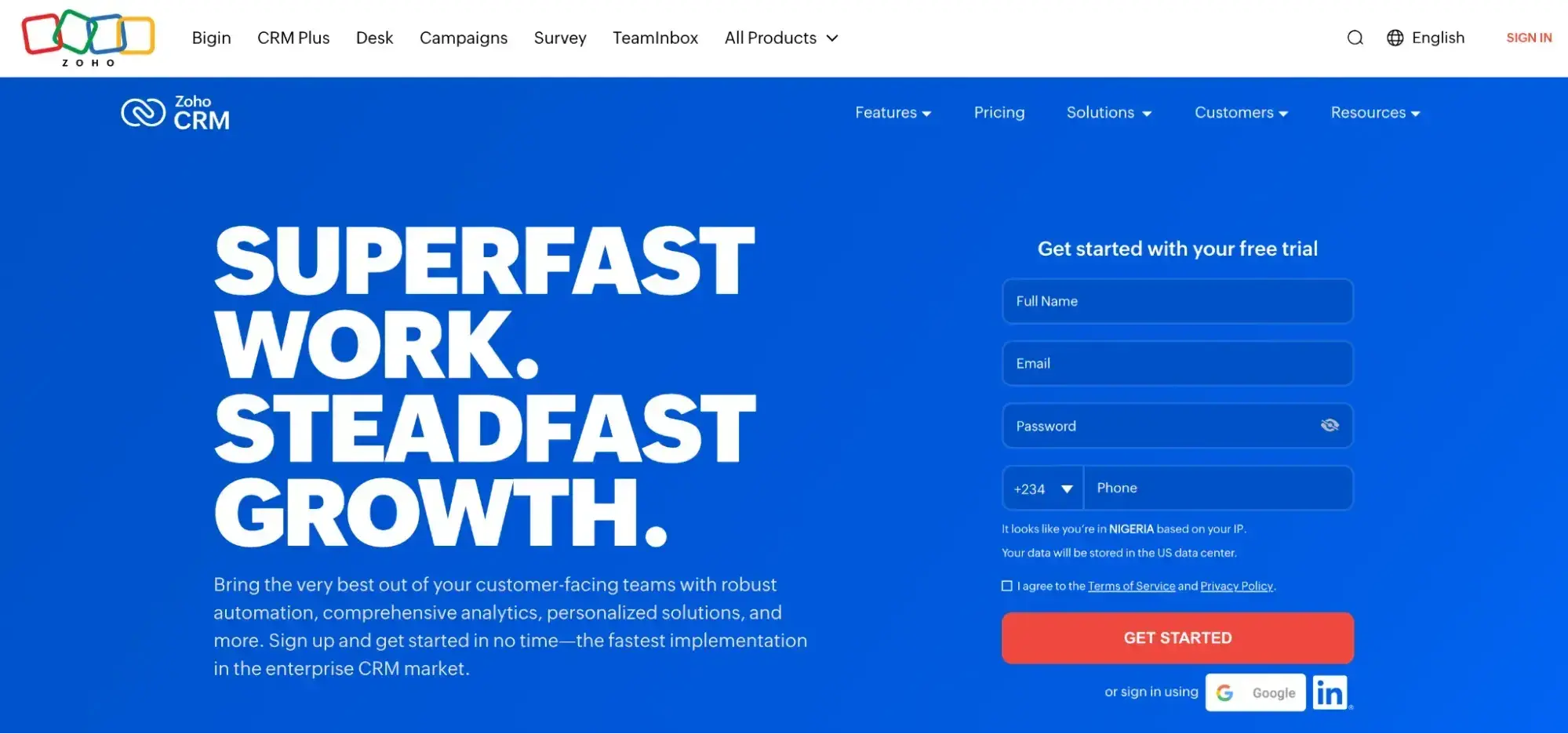
Zoho is a CRM that’s fully cloud-based, integrated, and offers a variety of features including lead management and scoring, workflow automation, analytics, and marketing and process management.
Zoho’s AI sales assistant, Zia, interprets CRM data, tracks website visitors, and predicts sales. These sales predictions also surface leads who are most likely to convert and deals that are most likely to close.
Zoho’s gamification feature keeps your reps motivated and focused on quota while the Google Ads integration aligns your sales and marketing teams by bringing your business’s ad spend and sales revenue to light.
Lastly, you can use Zoho to provide omnichannel support for customers and leads over the phone, email, live chat, social media, or in person.
Example of Zoho in Use: Provide an Omnichannel Customer Experience
Zoho allows you to provide an omnichannel customer experience for your contacts — meaning you can support your audience via email, live chat, social media, or an in-person meeting, all without ever leaving the CRM. Any data obtained through these interactions will be saved to the CRM automatically.
Bring all of your emails into the CRM and send messages directly from the tool. Your email conversation history will be updated and saved after every correspondence.
The same goes for your phone calls — take and receive sales and support calls from Zoho, so all conversations are logged and you don’t ever have to leave the tool. You can also host meetings and lead presentations from the CRM.
Testing It Out
I found Zoho CRM’s AI assistant, Zia, to be an incredibly versatile and intelligent tool. Zia’s conversational capabilities are particularly impressive as it can understand both text- and voice-based commands and queries. I can call and speak to Zia directly, which makes it easy to get real-time insights and updates on sales activities.
In addition to facilitating a quick, hands-free interaction, Zia can also predict sales outcomes by analyzing past sales data and patterns. Its anomaly detection capabilities are also admirable; it can alert you to any irregularities in your sales data, such as sudden spikes or drops in activity. This allows you to address potential issues proactively.
Pricing
There’s a 15-day free trial available. The paid pricing plans include the following:
- Standard. $14/user/month.
- Professional. $23/user/month.
- Enterprise. $40/user/month
- Ultimate. $52/user/month
These plans are billed annually.
7. BIGContacts
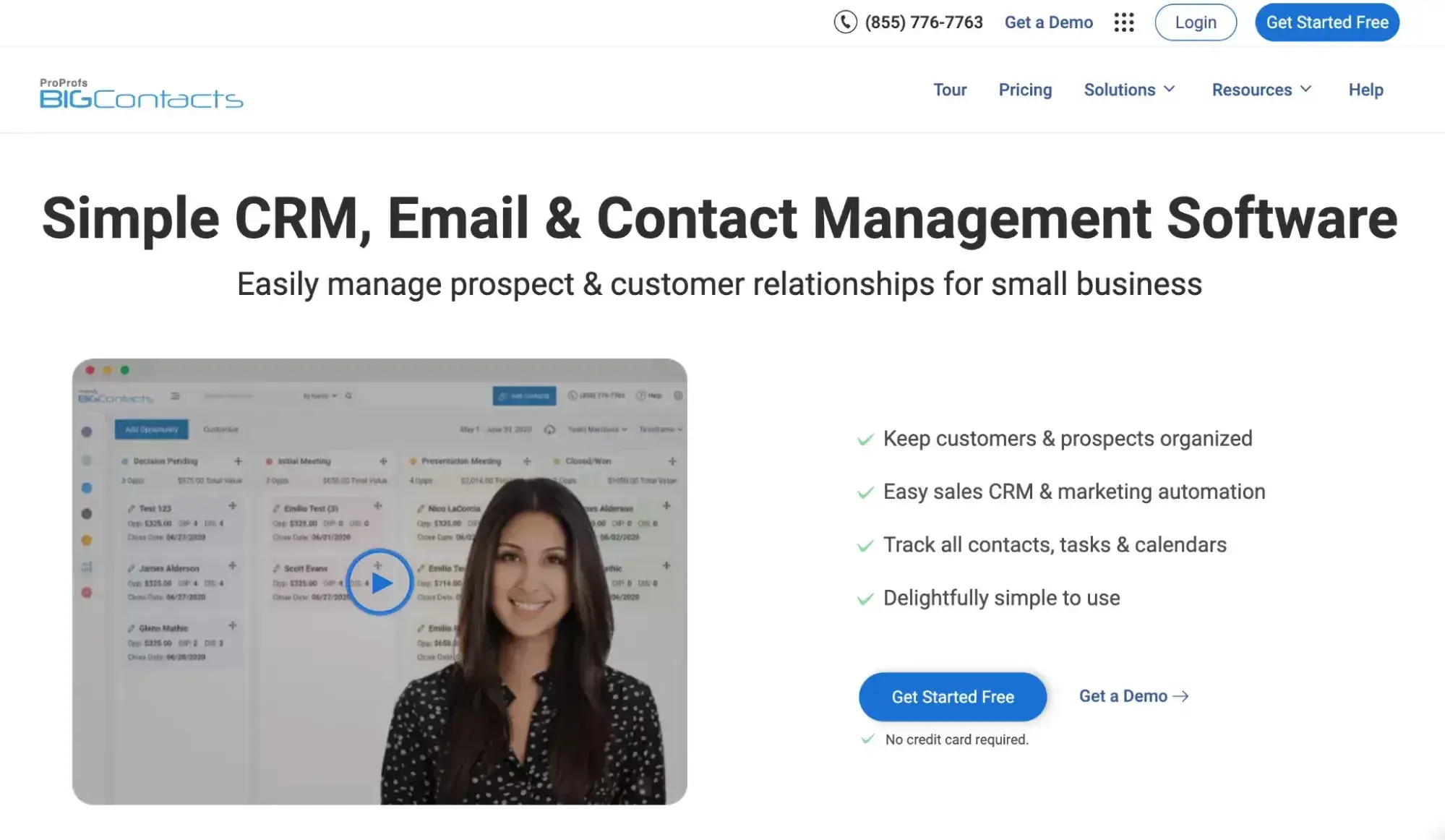
BIGContacts simplifies customer relationship management with its easy-to-use design and intuitive interface. The CRM tool is a reliable way for businesses to stay on top of all customer data and interactions. It provides a 360-degree view of contact data, including previous touches, social media profiles, notes, files, and upcoming activities. The tool enhances team collaboration, provides actionable business insights, and helps increase organizational productivity.
BIGContacts offers sales pipeline management, webform connection, lead nurturing, and task tracking. There are also custom reports and dashboards that allow you to gain better visibility into your business operations.
BIGContacts can also be a powerful tool for task management with detailed calendar views, automated recurring tasks, and custom reminders.
Example of BIGContacts in Use: Personalized Drip Campaigns
Personalized interactions play a monumental role in improving customer relationships. They help customers feel valued, contributing to improved brand loyalty and customer retention. BIGContacts helps businesses leverage the customer data available to craft more meaningful and engaging experiences.
Automated drip email campaigns that adjust based on contact activities can be set up using BIGContacts. These emails allow you to connect with prospects and customers at the right time. Furthermore, email templates are available, which can save a considerable amount of your time. You can also create your templates and save them for future use.
Testing It Out
One of BIGContacts’ core features is its AI-powered contact data standardization feature, which uses advanced algorithms and machine learning to analyze and transform raw contact data into a uniform format. Not only does this streamline data management, but it also reduces the chances of errors typically seen with manual processing.
The application of AI here changes the daunting tasks of manually ensuring data consistency across multiple platforms into a straightforward, automated process. The benefits are immediately noticeable, as it simplifies data analysis, customer segmentation, and targeted marketing efforts.
I was particularly impressed with how the AI tackled complex datasets to ensure accuracy and uniformity in contact information.
Pricing
There’s a free forever plan available for up to 100 users. The paid plan costs $9.99/month for up to 1,000 contacts, billed annually. If you’re managing over 20,000 contacts, you’ll need to talk to BIGContacts’ team for custom pricing.
8. Pipedrive
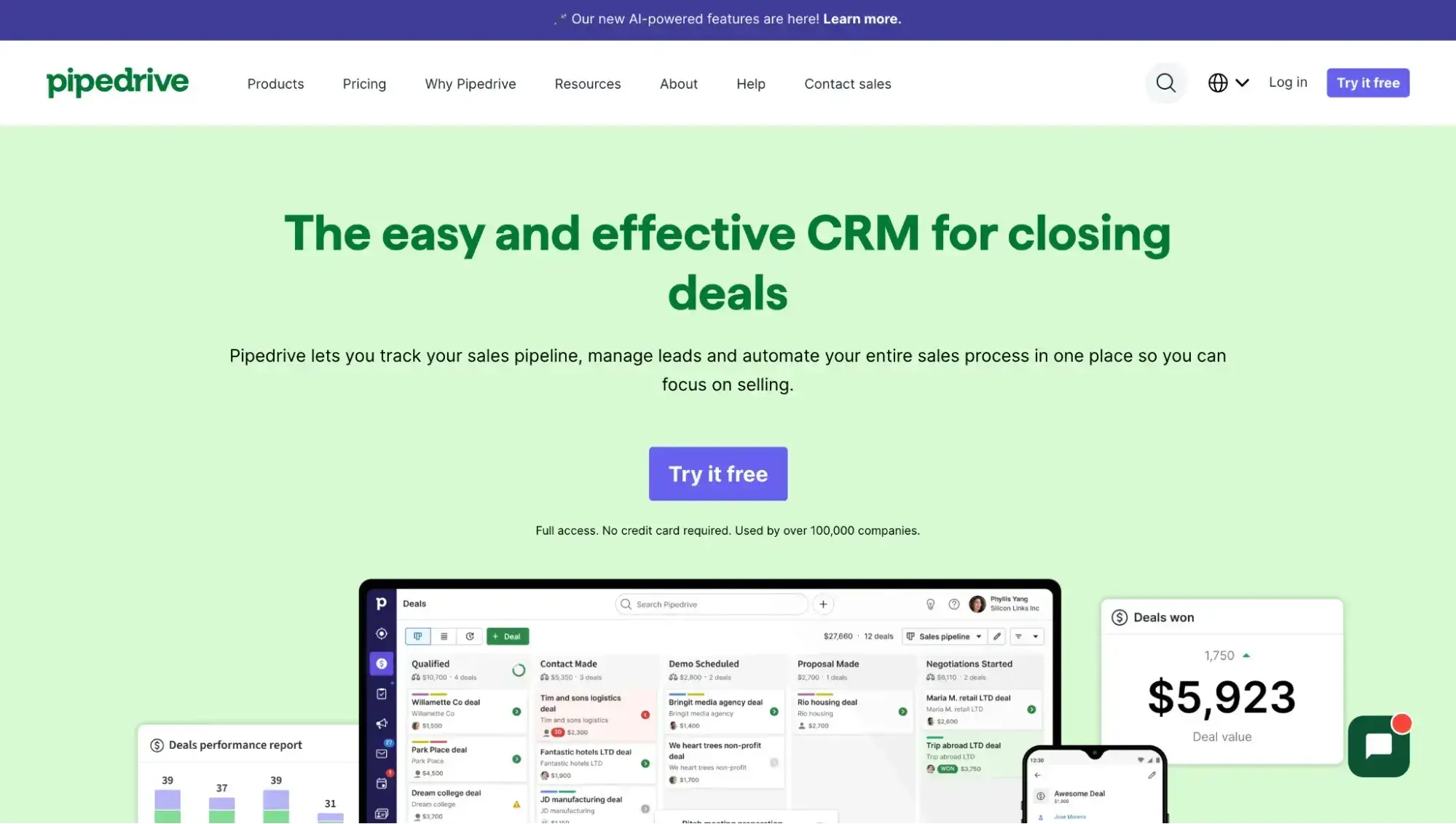
Pipedrive is a sales CRM and pipeline management tool ideal for small teams. The software comes stacked with features for tracking performance, managing deals, predicting revenue, and automating repetitive tasks. Pipedrive automatically visualizes your pipeline so you’re able to identify where your efforts should be focused.
Pipedrive includes sales forecasting and integrations so you can pair your current tools such as Mailchimp or Zapier with your CRM. There’s also a security feature that clarifies how your business data is being used.
Example of Pipedrive in Use: Track Your Data and Security
Use Pipedrive to keep track of your data and security — the software monitors all ways in which your company’s data is accessed and who’s accessing it. Identify suspect users and activities in real-time, all via a single security dashboard. Set notifications that alert you about when and where user log-ins occur. Lastly, create custom rules for secure practices (e.g., time-restricted access) to keep your CRM data safe.
Testing It Out
Pipedrive’s AI tool suite is exceptionally useful. I found that the AI Sales Assistant is able to provide actionable insights and recommend the next best actions for deals, which helps you make timely and informed decisions.
The AI email generator is also effective at creating compelling sales emails from simple prompts, which helps to overcome writer’s block and personalize messages at scale.
I also found the AI email summaries feature to be a huge time-saver as it condenses long email threads into brief summaries, providing clarity on the lead’s interests and suggesting viable steps to take next.
Pricing
There’s a 14-day free trial available. The paid plans include:
- Essential: $14/seat/month
- Advanced: $39/seat/month
- Professional (including AI): $49/seat/month
- Power (including AI): $64/seat/month
These plans are billed annually.
9. Freshworks
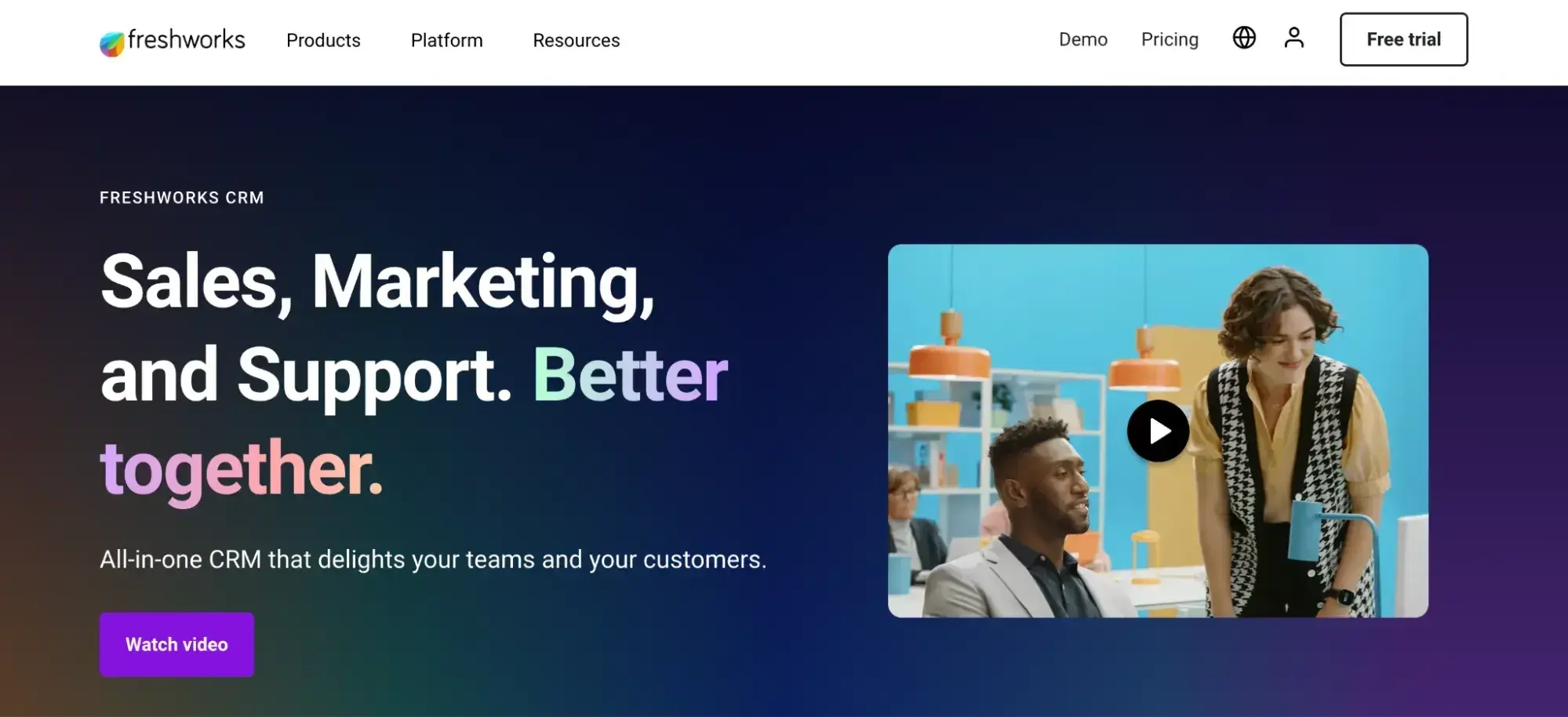
Freshworks is a sales CRM and customer engagement platform that uses AI to help your sales and marketing teams provide personalized customer experiences. Freshworks is split into the Sales Cloud and Marketing Cloud.
The Sales Cloud assists with lead attraction, lead qualification, and deal engagement. It also uses AI to forecast sales and predict which actions reps should take with prospects.
Marketing Cloud helps you conduct automated conversations with customers via an AI-powered chatbot. It also uncovers details about audience behavior and engagement so you can determine where to focus your efforts and how to create highly targeted campaigns and experiences.
Example of Freshworks in Use: Align Sales and Marketing
Sales and marketing alignment is critical to the success of any business. A CRM like Freshworks has the power to align your sales and marketing teams to increase productivity, improve collaboration, and enhance the customer experience.
Freshworks organizes and updates contact and engagement data in a single location — thanks to the Customer-for-Life Cloud feature — so sales reps and marketers know exactly who they're targeting.
Testing It Out
Freshworks created a handy AI assistant (or coach, depending on the use case) called Freddy AI, which helps both customers and employees boost their productivity. I really like Freddy Self Service, which allows sales reps to deploy intelligent chatbots to quickly resolve customer issues 24/7. This frees up time for support reps to focus on more complex tasks.
Freddy Copilot comes in handy for employees as it can summarize issues and discussions, suggest next steps, and automate repetitive tasks with conversational prompts. And Freddy Insights provides AI-driven insights that give employees a 360-degree view into their operations, so they can fix any issues and spot viable opportunities.
Pricing
There’s a 21-day free trial available. The paid plans include:
- Growth, $9/user/month.
- Pro, $39/user/month.
- Enterprise, $59/user/month.
These plans are billed annually.
10. ActiveCampaign
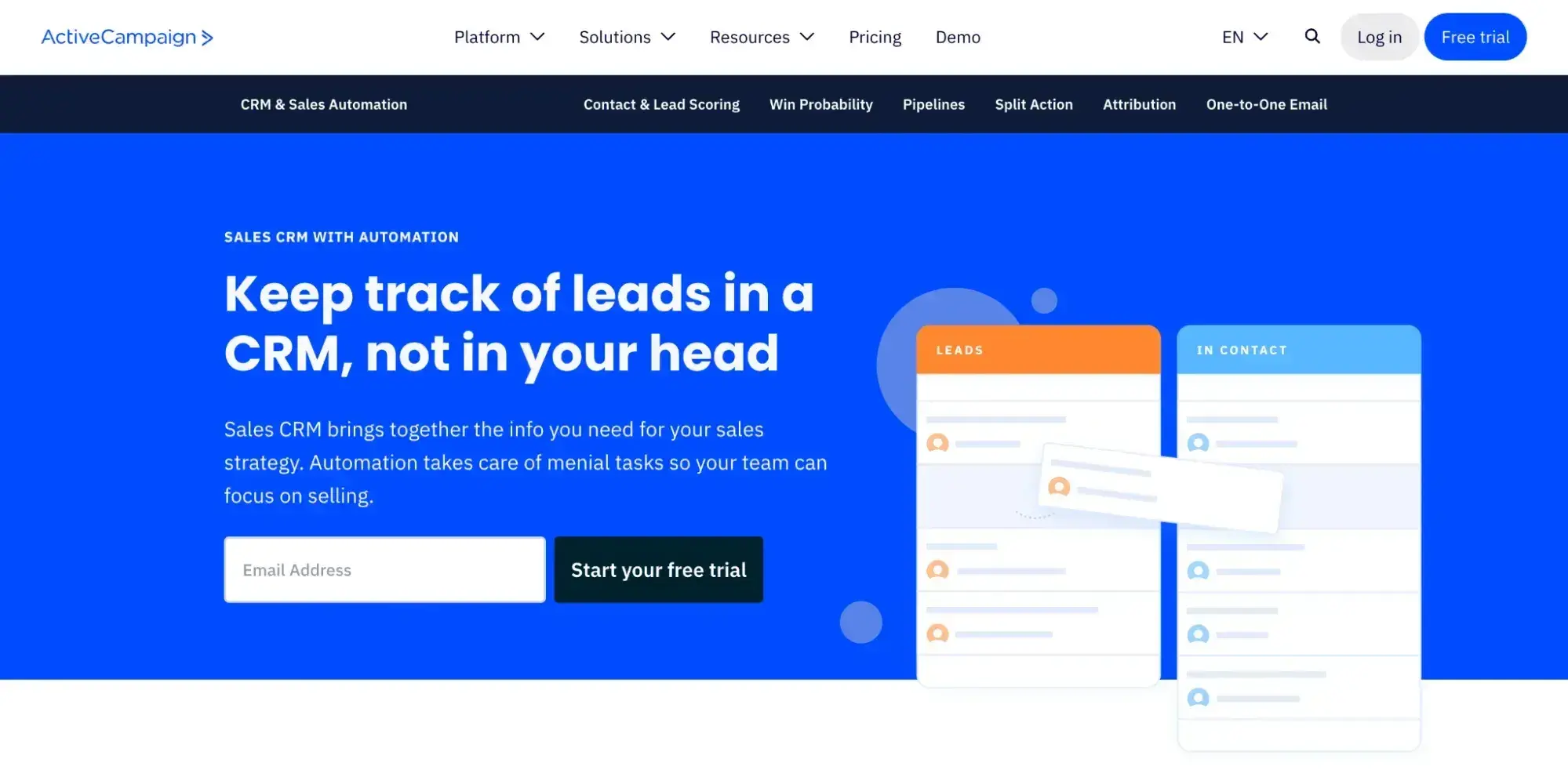
ActiveCampaign is a customer experience automation platform and CRM with a number of tasks and job functions you can automate across social media, email, live chat, SMS, and more. There are over 300 integrations — such as Shopify, Facebook, and WordPress — that you can use to tailor the CRM to your specific needs.
ActiveCampaign makes it easy to share customer lifecycle data cross-team and use it to make informed decisions about your interactions with customers (e.g., what content you should send to them, when to reach out, and what channel to leverage).
ActiveCampaign also helps you better understand your customers on an individual basis and effectively segment them by tracking buyer preferences, engagement, behavior, and unique traits.
This, along with other features like customizable campaigns and messages, allows you to personalize all communication with prospects and customers.
Example of ActiveCampaign in Use: Personalize Customer Experiences
A CRM organizes a lot of data about your customers on an individual basis — and a CRM like ActiveCampaign makes it easy to apply this data to create personalized customer experiences.
ActiveCampaign uses machine learning to automate personalization across various channels. As your business grows, you can continue to automate these one-on-one experiences to ensure every customer feels like they're an individual who matters to your business.
ActiveCampaign also has customizable Personalization Tags and Deal Fields. These features allow you to add tailored, dynamic content to campaigns, emails, SMS, web forms, deal follow-up messages, and more, allowing you to tailor all communication to each individual.
Testing It Out
When I delved into ActiveCampaign’s AI capabilities, I found their AI-powered automation builder remarkably intuitive and efficient. The feature combines flexible actions with conversational AI and a user-friendly drag-and-drop interface to help you create automated email and SMS campaigns.
All you have to do is visually map out the journey you want to take your customers on, add triggers and touchpoints, and schedule when you want it to go into effect.
The generative AI feature impressed me as well. With just a few inputs on my end, the system suggested engaging and relevant email content that resonates well with my predefined target audience. This saved a ton of time and improved the personalization of my campaign.
I also explored the predictive email-sending feature, which uses AI to determine the optimal time to send emails based on contacts’ behavior and engagement patterns. This results in higher open rates for email campaigns, which can improve ROI.
Pricing
There’s a 14-day free trial available. The paid plans for the CRM and sales engagement platform include:
- Starter: Starting at $15/month
- Plus: Starting at $49/month
- Pro: Starting at $79/month
- Enterprise: Starting at $145/month
These plans are billed annually.
11. Close
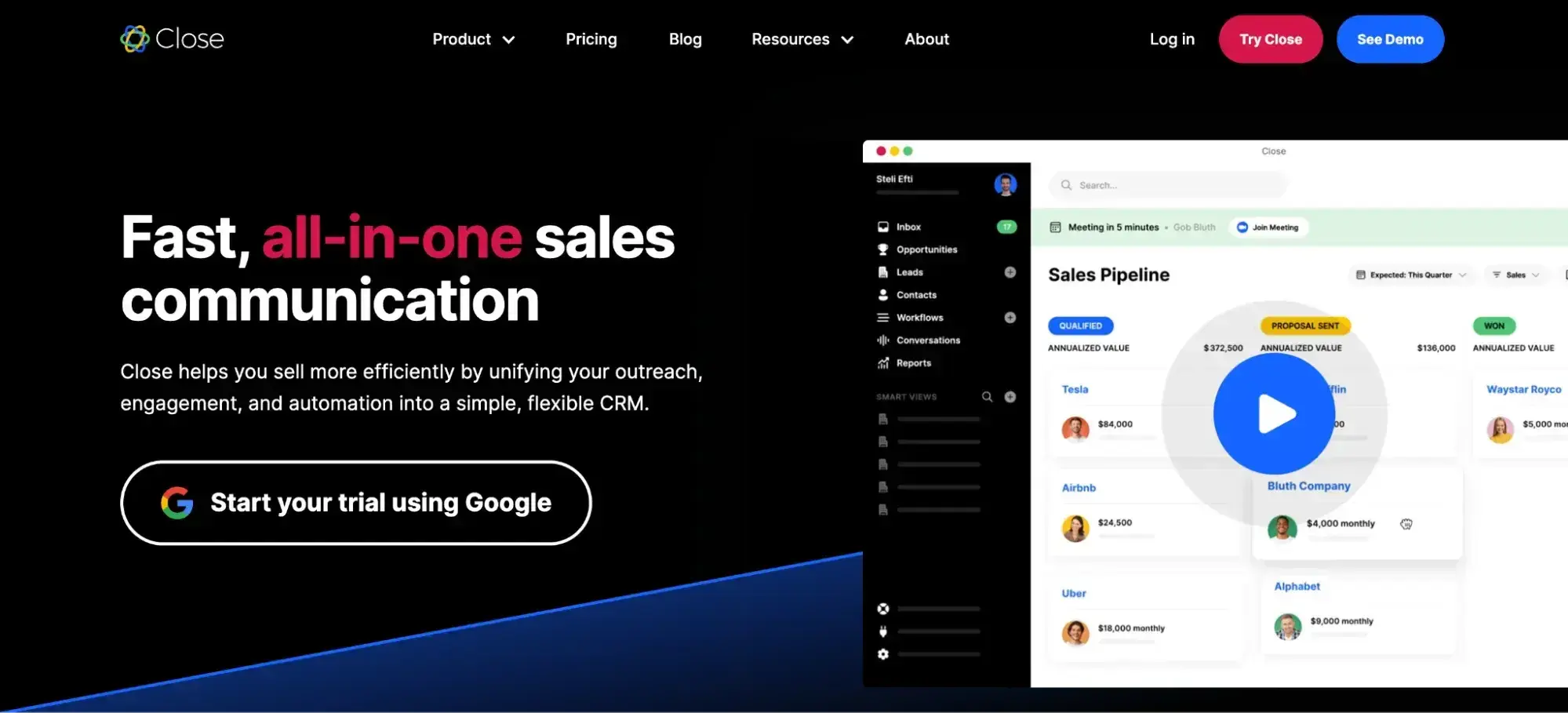
Tailored specifically for small and medium-sized businesses, Close offers a streamlined and efficient approach to managing customer interactions, tracking sales activities, and optimizing workflows.
This platform integrates communication tools such as email, phone, and SMS, which allows you to handle all your communications from one place, reducing the time spent switching between different tools and increasing overall efficiency.
Close also automates repetitive tasks such as follow-ups, reminders, and data entry, which ensures that no leads fall through the cracks and that you can focus on what you do best.
Example of Close in Use: Built-In Calling
One of Close’s standout features is its built-in calling functionality, which transforms how sales teams conduct their cold outreach and manage customer interactions. For example, I found that with Close, you can make and receive calls directly within the platform using VoIP technology. This eliminates the need for external phone systems and keeps all communication records centralized.
Whenever you make calls through Close, the platform automatically tracks and logs the call, providing valuable data on call duration, outcomes, and follow-up actions. The calls can also be recorded and stored for future reference or training purposes.
Testing It Out
During the testing process, Close GPT stood out to me. It’s like ChatGPT, but it’s tailored to quickly generate sales prospecting lists, summarize customer relationships, and create meeting agendas, among other things. I also loved the Call Assistant feature that automatically transcribes and summarizes all client (and cold) calls to help sales teams stay productive.
Close’s free AI tools were also pretty decent. The cold email generator, subject line generator, and AI email writer were designed to automatically create personalized and relevant emails that increase open and response rates, and scale the outreach process.
Pricing
There’s a free 14-day trial available. The paid plans include:
- Base: $19/user/month.
- Startup. $49/user/month.
- Professional. $99/user/month.
- Enterprise. $139/user/month.
These plans are billed annually. If you have more than 10 reps, you can call to create a custom plan.
12. NetSuite
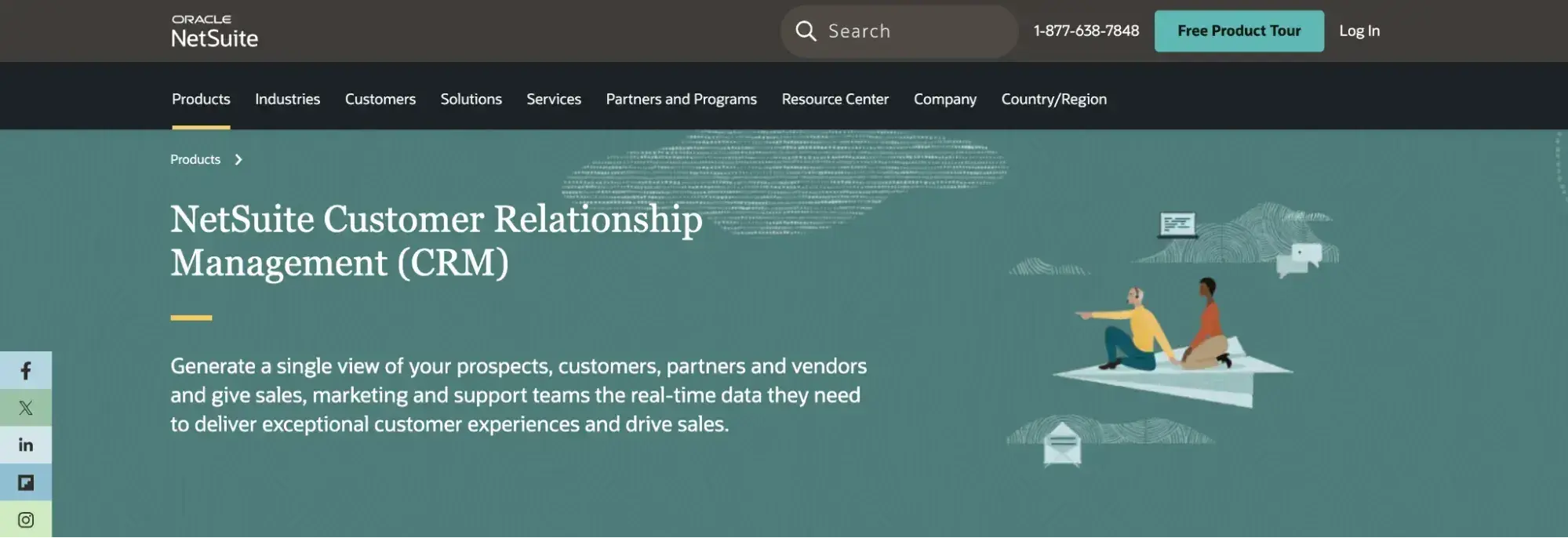
NetSuite is a comprehensive CRM solution offered by Oracle’s NetSuite. Designed for businesses of all sizes, this platform provides you with a bird’s-eye view of your customers, allowing you to manage the entire customer lifecycle, from lead generation to opportunity tracking, customer service, and order management.
As part of the broader NetSuite ERP suite, this tool integrates seamlessly with financial, inventory, and ecommerce systems, offering a unified platform for managing all business operations. NetSuite automates key sales processes such as lead assignment, sales forecasting, and territory management. This reduces manual tasks, increases efficiency, and ensures you can focus on building strong relationships with your customers and closing deals.
Example of NetSuite in Use: Sales Force Automation
NetSuite’s Sales Force Automation (SFA) capabilities are designed to enhance the effectiveness and productivity of sales teams. For example, the platform helps you manage leads and opportunities by capturing detailed information about prospects and tracking their progress through the sales pipeline. This allows you to easily view and update lead statuses, ensuring that no deal opportunity is ignored.
NetSuite also offers robust forecasting tools that provide visibility into future sales, which helps you plan resources and manage inventory effectively. These sales forecasts can be adjusted based on real-time data, which makes them highly reliable.
Testing It Out
When I tested NetSuite’s AI capabilities, I was impressed by how effective they were at enhancing various aspects of the marketing and sales workflows. For example, the AI-driven invoice processing feature can automate the entire invoicing process, from data extraction to payment tracking, which significantly reduces manual effort and minimizes errors.
The content generation tool was another highlight. I found that, by using AI and machine learning, NetSuite can create personalized content for customer communications and marketing campaigns. The ability to generate relevant and engaging content based on customer data and behavior is a game-changer when it comes to improving engagement and conversion rates.
Pricing
Users can subscribe to NetSuite CRM for an annual license fee, which covers the number of users, core platform, and optional modules. You’ll have to contact NetSuite’s team for custom pricing.
Types of CRM (with Examples)
As you’ve seen, there are CRM options for just about every use case. In testing these options, I’ve found two things to be true:
Not all CRMs are created equal.
And that’s okay. Some businesses need a super-robust CRM to manage all aspects of their business, while others need a simpler solution. What matters most is finding one that works for you now and can grow with your business so you don’t have to go through the time, labor, and cost-intensive process of migrating to a new platform.
AI is making CRMs better.
Although AI is certainly controversial when it comes to privacy and its growing sophistication, there’s no doubt that it unlocks a ton of incredible insights.
In fact, AI is taking CRMs to the next level, from — for lack of a better word — a simple database for storing information to a tool that yields significantly better business intelligence (BI). In addition to optimizing sales, predicting growth, and identifying potential new buyers, I’ve found that AI-powered CRMs bridge all the “traditional” CRM functionalities and make it easier for sales people to do what they do best — drive revenue.
So what are the “traditional” CRM functionalities? Most fall into three categories: Operational, Analytical, and Collaborative. That said there are a few more speciallized types of CRMs.
While several CRMs, including the HubSpot CRM with AI, bridge them all, I’m going through each type below and sharing potential use cases so you can determine which is likely best for your needs.
1. Operational CRMs
In a nutshell, operational CRMs manage all of the business processes across sales, marketing, and servicing customers. Basically, they cover all aspects of the customer journey and automate as much as possible, minimizing manual workarounds and data entry.
Best for: Growing businesses that want to align their teams, streamline processes, and improve customer interactions.
Key Features of Operational CRMs
- Sales automation to track leads, automate follow-ups and reminders, and help move potential customers through the journey.
- Marketing automation to automate messaging, email campaigns, and lead scoring.
- Customer service tools to manage support tickets, deliver a better customer experience, and improve team morale.
Example of an Operational CRM in Action
The Challenge: Hypothetically, a mid-sized tech company selling software subscriptions struggles with manual follow-ups and missed opportunities.
The Operational CRM Solution: With an operational CRM, when a prospect downloads a whitepaper, they are automatically added to a nurturing campaign, assigned to a rep, and reminded to follow up if they don’t respond. Meanwhile, the system logs all interactions, ensuring customer support sees past conversations when the same prospect later reaches out with questions.
2. Analytical CRMs
The best way I’ve seen analytical CRMs described is that they focus on understanding. Where operational CRMs focus on doing, and collaborative CRMs focus on — well — collaboration, analytical CRMs put the data at the forefront and make it easier for companies to make informed, data-driven decisions.
Best for: Data-driven businesses that want to improve marketing and sales strategies.
Key Features of Analytical CRMs
- Customer data analysis to help sales teams identify specific touchpoints, trends, and areas of friction in the customer journey.
- Sales forecasting to help sales teams predict future sales.
- Customer segmentation to make it easier to create messaging and campaigns targeted to specific groups.
Example of an Analytical CRM in Action
The Challenge: Again, hypothetically, an outdoor gear e-commerce brand wants to improve customer retention.
The Analytical CRM Solution: The analytical CRM tracks purchase behavior and reveals that customers who buy hiking boots often return for trekking poles within three months. Using this insight, they create a follow-up email campaign with a discount on trekking poles at the exact time customers are most likely to buy.
3. Collaborative or Strategic CRMs
Collaborative CRMs are all about seamless interaction so that every team marketing to, selling, to, or servicing a client can work together. Ultimately, the advantage of this type of CRM means that all team members are informed and the customer doesn’t have to repeat themselves. (I’ve been on both sides of the equation and both are frustrating.)
Best for: Companies that need seamless internal communications.
Key Features of Collaborative CRMs
- Comprehensive customer data so everyone is on the same page.
- Multi-access user controls, so each person has access to the data they need to work effectively.
- Internal team comms to help teams collaborate more effectively.
Example of a Collaborative CRM in Action
The Challenge: Loving my hypothetical examples? Let’s keep going. A real estate brokerage with multiple agents and an in-house legal team needs all departments to have access to client information, but not everyone needs the same level of access.
The Collaborative CRM Solution: The CRM allows agents to track client interactions and property searches, legal teams to access only transaction documents, and marketing to see how past clients engaged with listings and personalized follow-ups.
What’s more, the service and admin teams have access to important customer information, so clients enjoy a seamless experience regardless of who they talk to.
4. Campaign Management CRM
As you might guess, campaign management CRMs are marketing heavy and they’re all about ensuring that marketing efforts are unified and seamless. These CRMs fall into the specialized category. I’ve found that they can be standalone platforms, but often are features of more comprehensive CRM tools.
Best for: Companies heavily focused on marketing.
Key Features of Campaign Management CRMs
- Email & ad campaign tracking to oversee marketing efforts and measure performance.
- Customer segmentation to improve customer targeting and personalization.
- Marketing ROI calculators to measure and analyze success and identify opportunities to improve in the future.
Example of a Campaign Management CRM in Action
The Challenge: A hypothetical fitness subscription company has found they have poor customer retention and want to increase renewals before customers' annual plans expire.
The Campaign Management CRM Solution: By segmenting users based on frequency of engagement, creating personalized email sequences tailored to the level of engagement, and tracking open rates and responses, the company can improve engagement and become a must-have solution instead of “another subscription” people feel comfortable dropping at renewal time.
5. Social Media CRM
As you might guess, social media CRMs focus most heavily on social channels, including tracking all aspects of customer acquisition and reputation management, including ad targeting social listening. I’d consider these CRMs highly specialized as well. However, there are some social management platforms that incorporate these tracking aspects as well.
Best for: Brands with a heavy reliance on social media for growth and service.
Key Features of Social Media CRMs
- Social listening tools to stay on top of what people are saying about your company.
- Engagement tracking to improve the way you engage with customers.
- Audience analysis to identify potential brand ambassadors and simultaneously uncover new leads.
Example of a Social Media CRM in Action
The Challenge: A skincare brand launches a new product and wants to track online buzz.
The Social Media CRM Solution: Their social media CRM monitors brand mentions across different platforms, identifies customers who frequently engage with their content, and notifies the marketing team when influencers organically mention their product.
Using this data, they reach out to engaged customers for testimonials and launch a user-generated content campaign that leads to more sales.
6. Mobile CRMs
Mobile CRMs aren’t necessarily mobile-exclusive, but they have a high level of mobile functionality to make it easier for teams to collaborate from less traditional sales offices. Again, these are more specialized and often are a mobile-enabled aspect of larger, more robust CRMs.
Best for: Companies with remote teams, traveling service techs, and field sales reps who need CRM access on the go.
Key Features of Mobile CRMs
- Mobile app functionality to make it easy for teams to access the CRM from mobile devices.
- Offline access to simplify service even without internet availability.
- Push notifications to make sure teams get alerts about important customer updates.
Example of a Mobile CRM in Action
The Challenge: Let’s say a solar panel installation company has sales reps and installation teams who are at different locations on a daily basis. They want to make sure all teams can update their data regularly so that anyone can speak authoritatively to the customer if and when they call. (I have a non-solar service-based client who runs into this very issue, who chose their CRM based on its mobile app — among other functionalities.)
The Mobile CRM Solution: Their mobile CRM lets them quickly access client details before meetings, update customer status on-site, syncing automatically once back online, and receive push notifications if a lead they contacted a week ago reaches out again.
So, what CRM is right for you? Ultimately, every business has different CRM needs, so take some time to analyze what you need most and how you anticipate your company changing in the coming years. Then go back through this list and try the top 2-3 best-fit solutions to see which you and your team like best.
Choose Your CRM
There are a number of ways to use a CRM — and the use cases I shared above are just a handful of them. Start thinking about your goals and needs to select the right CRM for your team. Then, use your CRM to start building stronger relationships with contacts, improve the customer experience, save your team time, align business data, and grow better.
Editor's note: This post was originally published in January 2021 and has been updated for comprehensiveness.


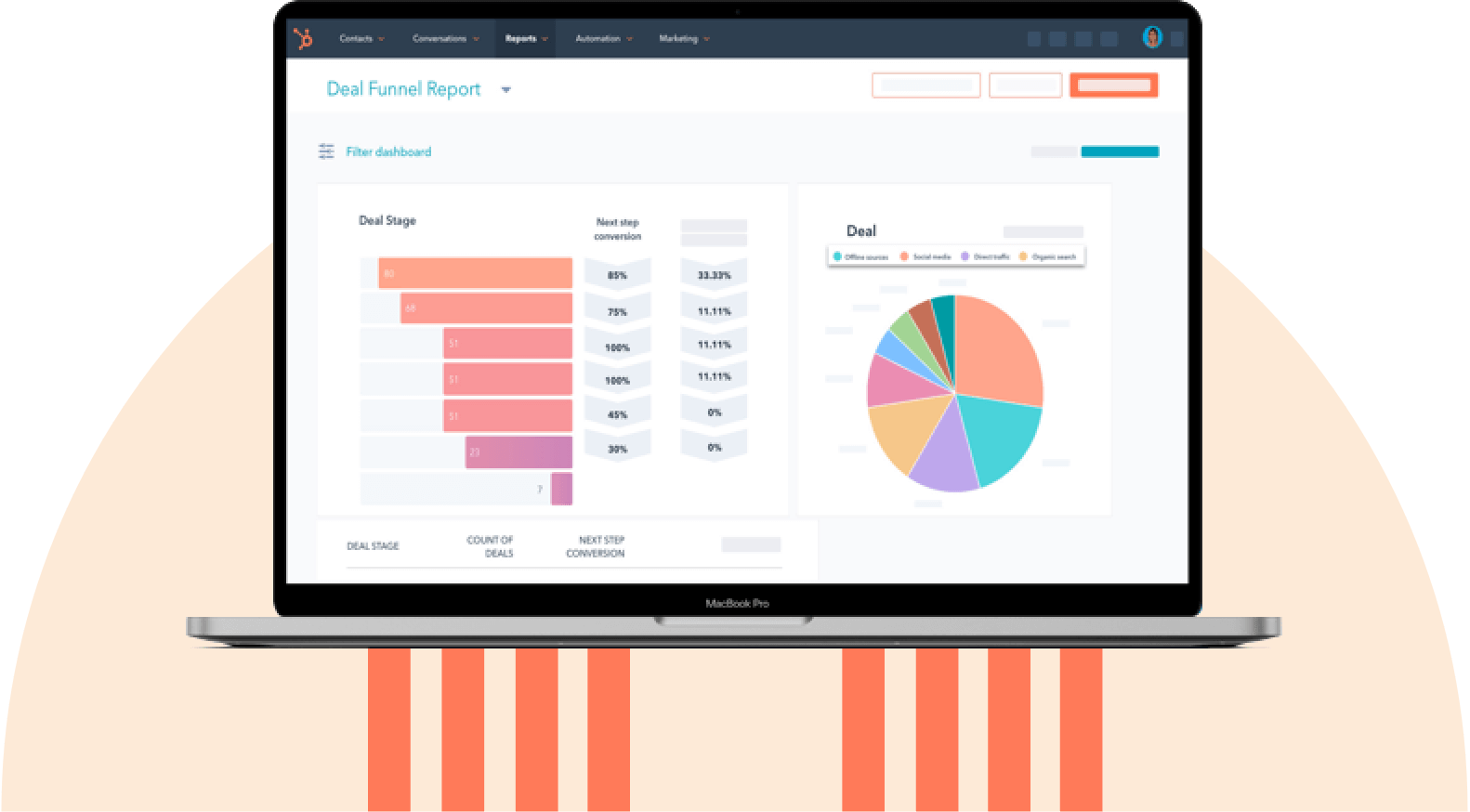









.png)